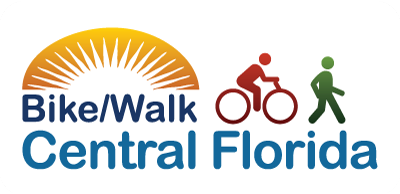Our region is working hard to make roads for safer for everyone, especially bicyclists. The City of Orlando is no exception.
Fifty sharrows are planned for Orlando’s roadways. The first one is in the of process being installed and will be completed by February or March of this year.

Orlando adds ‘sharrows’ in push for bike-friendly streets
By Jeff Weiner | January 10, 2016
As Orlando continues to battle its perception as an unfriendly place for bicyclists, the city is adding the “sharrow” to its quiver.
A word blend of “share” and “arrow,” the term describes roadway markings intended to guide bike riders along a safer path through city streets while reminding motorists that the road is for cyclists, too.
Orlando is installing its first sharrow route along a road that will eventually connect the Orlando Urban Trail’s eastern end near Lake Highland with the Cady Way Trail’s west end near Lake Druid.
“It’s basically just a low-speed, low-volume route that is probably the most comfortable and convenient way to get from the Urban Trail to the Cady Way Trail,” says city planner Ian Sikonia.
It’s long been the city’s suggested path between the two trails, marked off with roadside signs, but according to Sikonia, some bikers have said they get lost.
Enter sharrows, which are roadway markings depicting a bicyclist under two arrows pointing along the route. They’re similar to bike lanes, but placed in the main roadway rather than alongside it.
In all, the city plans to install nearly 50 of the markings, which are made of preformed thermoplastic, at a cost of about $11,000. Installation began in November along the route expected to be complete by February or March.
Four are already in place, including at Lake Highland Drive and Ferris Avenue.
Orlando could also eventually add more routes if the first one is well-received, officials said.
As much as anything, the goal of sharrows is education, said Amanda Day of Bike/Walk Central Florida, an advocacy group for bicyclists and pedestrians. They help to alert drivers to keep an eye out for bikes sharing the roadway, and to guide bicyclists on the best places to commute.
Florida law gives bicycles equal right to roadways, but transportation officials say not all drivers know that. Sharrows and other markings help reinforce the “peaceful coexistence” the law intends, Day said.
“They send a wordless message to drivers and cyclists, to learn to share the road,” Day said.
Orlando isn’t the only local city to embrace a shared on-street route. Winter Park has had sharrows in place on Palmer Avenue for almost a decade, according to the city’s traffic manager, Butch Margraf.
“In the very beginning, people didn’t know what they were … ‘Does this mean I can’t drive my car there anymore?'” Margraf recalled, describing the confusion as a “learning curve.”
Winter Park is putting together an official citywide bicycling route, with additional sharrow routes, potentially including stretches of Winter Park Road and Denning Drive, Margraf said.
Winter Park has made a major push toward bicycle friendliness in recent years. In 2008, the city owned only enough racks to hold 12 to 15 bikes; by 2015, the city boasted a bike-parking capacity of more than 500.
In November, Winter Park was awarded a bronze rating by the League of American Bicyclists, joining Orlando and south Lake County as the only local communities recognized as bike-friendly by that organization.
The sharrow lane comes as bicycle and pedestrian amenities become a significant focus for Orlando planners. The city’s recent downtown visioning project urged more bike lanes, better-linked trails and improved crosswalks.
Launched last year, the city’s bike share service now has more than 30 hubs; bike-repair stations were recently added to four spots along popular paths; and plans are advancing for a pedestrian bridge across Colonial Drive.
Orlando is frequently cited as a perilous place to walk or bike. It was ranked the nation’s most dangerous metropolitan area for pedestrians in a 2014 nationwide study, which reported 583 deaths between 2003 and 2012.
Sharrows won’t fix that alone or overnight, but they’re a step in the right direction, Day said.
“It’s just one tool of many tools, it’s not the only tool … hopefully, over time people will be more aware,” she said.

